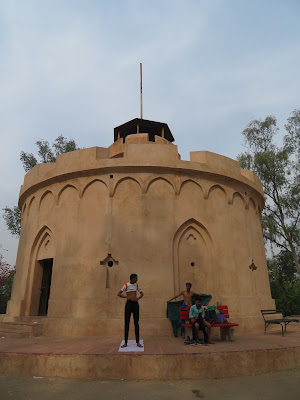We have been to Delhi before, so what we wanted to see today was a bit off the usual tourist track. Our guide hadn't seen some of them, but using his knowledge of history and Google, willingly came along.
The oldest thing we saw was Ashoka's Pillar, aka Delhi-Meerut Pillar.
Ashoka had many pillars across India, including one at Sarnatah whose
capital (top bit) forms the Indian national symbol. This one was not
much to look at, missing its top bit, and previously broken but put back together, but it
dates from 250BC, so that makes it old.
Fast Forward to the time of the British East India Company. It began in the 1600s as a trading company, and had its own army to maintain security (as someone said, think Microsoft with guns). It gradually took over ruling functions, first in Bengal and then further afield. When resentment against the company reached boiling point in 1857, there was a major outbreak of violence, called the Indian Mutiny or First Indian War of independence, depending on your point of view.
Europeans and Indian Christians were attacked (mind you there was huge violence on both sides) and victims fled to Flagstaff Tower for refuge. This tower is now in the grounds of Delhi University.
Kin Mun and our guide. He (Sanjeev) knew about the tower because he had studied (and courted his wife) at Delhi Uni.
When the battle was over, and the English regained control of Delhi, they built a memorial to celebrate the victory. It is beautiful, architecturally.
And it is possible to climb to the top, via a circular staircase. But the door was locked - whew! I note the Brits gave this one a rail - why didn't they do that when they built bell-towers?
In 1972, the Indian Government renamed the memorial Ajitgarh, to celebrate all those who died during the Indian War of independence.
Just to keep to the violent theme, the caretaker told our guide that it had been a bad area and murders had occurred around the memorial.
By then we were hungry, so Sanjeev took us to a university canteen where he used to meet with his now wife to eat sweet samosas. Sentimental for him, a new experience for us!











No comments:
Post a Comment
Note: only a member of this blog may post a comment.